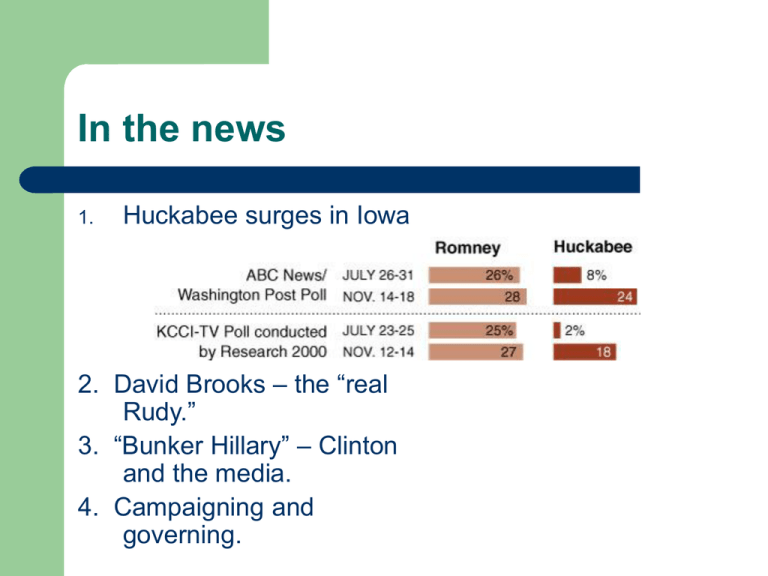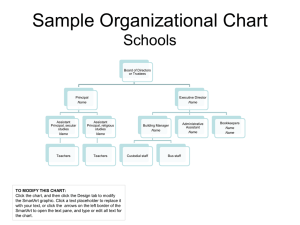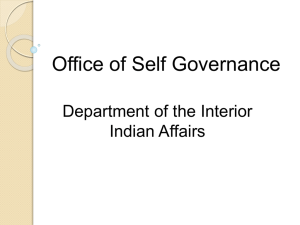Presidential Staff and Presidential Style
advertisement

In the news 1. Huckabee surges in Iowa 2. David Brooks – the “real Rudy.” 3. “Bunker Hillary” – Clinton and the media. 4. Campaigning and governing. Presidential Staff and Presidential Style Evolution of the President’s staff Burke – the “institutionalized presidency” is a relatively recent development. Presidents in the 19th century had almost no staff. Now it costs about $150 million a year to staff the White House. Brownlow Committee set up by FDR to recommend changes. Concluded “the president needs help.” Two-pronged approach: institutional and personal assistance. Staff, cont. Institutional includes the OMB, CEA, NSC, Trade Rep, Office of Policy Development, Council on Environmental Quality, Office of Science and Technology Policy, Office of Administration, and the Office of National Drug Control Policy. Personal includes speech writers, communications, media (press secretary), legislative, and legal assistants. Organizing the White House Approaches to coordination Competitive – FDR. Overlapping responsibilities, not very organized. Formalistic – Truman, Eisenhower, Nixon, Reagan, and Bush I+II (but Karl Rove rather than Andrew Card for George W. Bush). Hierarchical, division of labor. Chief of staff plays a central role in controlling the flow of information to the president. LBJ tried this for about a week – discarded it when one memo didn’t get through to him. Organizing the White House, cont. Collegial – Kennedy, Ford, Carter (but switched to formalistic), and Clinton. Spokes of the wheel. General tendencies: centralize, bureaucratize, and politicize. Pros and cons of each approach. – – efficiency, loyalty, good information, good staff relations. Isolation, chaos, redundancy, lack of expertise about the workings of government, demands on president’s time. Presidential Staff and Presidential Style The President’s staff The Chief of Staff – duties and responsibilities vary by president, but has been a key player since Eisenhower. Plays the role of information broker, lighting rod, and personnel manager. The “Brownlow Creed” Anonymity – staff should operate in the background. If you make the news, you have failed the president. Size of the staff – “small is beautiful,” yet staff grows. Coordination vs. management The “creed” vs. reality The Cabinet Rudalevige – “the assembled heads of the executive departments.” Originally four, now 15 agency heads, plus VP, chief of staff, OMB, Trade Rep, EPA, and Drug czar. “adult show and tell.” Not a collective decision making body. Clearly not “cabinet government.” Body is too big, too diverse, divided loyalties, and frequent turnover. So what purpose? Represent different constituencies, lead on specific issues, help implement the president’s agenda. Advising the President The process of advising the President – how to convince the Pres. he is making a wrong decision. What leads to policy failures? Keeping information from the public. The politics of advising the President – press loves to emphasize internal divisions within the White House, internal politics. Competition for space at the Cabinet table or office space in the West Wing. Assessing the advice on advising the President. What is the goal of the analysis: explanation or prescription? Problems with giving advice – need to have a better understanding of what works. First Floor 1.Jared Weinstein, Special Assistant to the President and Personal Aide 2.Karen Keller, Special Assistant to the President and Personal Secretary 3.Tony Snow, Assistant to the President and Press Secretary 4.Dana Perino, Deputy Assistant to the President and Deputy Press Secretary 5.Josh Deckard, Assistant Press Secretary 6.J.D. Crouch, Assistant to the President and Deputy National Security Advisor 7.Steve Hadley, Assistant to the President for National Security Affairs 8.Dick Cheney, Vice President 9.Karl Rove, Assistant to the President, Deputy Chief of Staff and Senior Advisor 10.Susan Ralston, Special Assistant to the President and Assistant to the Senior Advisor 11.Joe Hagin, Assistant to the President and Deputy Chief of Staff 12.Joel Kaplan, Assistant to the President and Deputy Chief of Staff for Policy 13.Josh Bolten, Assistant to the President and Chief of Staff Second Floor 1.Dan Bartlett, Counselor to the President 2.Kevin Sullivan, Assistant to the President for Communications 3.Candi Wolff, Assistant to the President for Legislative Affairs 4.Deb Fiddelke, Deputy Assistant to the President for Legislative Affairs 5.Allan Hubbard, Assistant to the President for Economic Policy and Director, National Economic Council 6.Keith Hennessey, Deputy Assistant to the President for Economic Policy and Deputy Director, National Economic Council 7.Liza Wright, Assistant to the President for Presidential Personnel 8.Bill Kelley, Deputy Counsel to the President 9.Karl Zinsmeister, Assistant to the President for Domestic Policy 10.Tevi Troy, Deputy Assistant to the President for Domestic Policy 11.Bill McGurn, Assistant to the President for Speechwriting 12.Harriet Miers, Counsel to the President Presidential Style Charles Jones’ categories of presidential styles: – – – – – – – LBJ: Majority leader. Nixon: Foreign minister. Ford: Minority leader Carter: Layman Reagan: Plebiscitary president Bush: combination of Nixon and Reagan Clinton and Bush II? The Vice President John “Cactus Jack” Nance Garner, gave up being Speaker of the House to become Vice President under FDR. He later said it was the "worst damn fool mistake I ever made." Office wasn’t worth “a warm bucket of spit.” John Adams, the first vice president, described the V.P. as "the most insignificant office that ever the invention of man contrived or his imagination conceived." Traditional duties – president of the Senate, attend state funerals. Harry Truman, HHH, and Bush I “out of the loop.” Changed with Al Gore, and even more with Dick Cheney. Gore was influential in foreign policy, environmental policy, and “reinventing government.” Cheney is widely viewed as Bush’s most influential advisor on a broad range of issues, esp. foreign policy. Stepping stone to the White House. VPs ran for office in 1960, 1968 (2), 1984, 1988, and 2000. Truman, LBJ, Nixon, Ford, and Bush I all served as VPs before becoming president.






